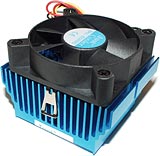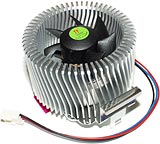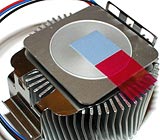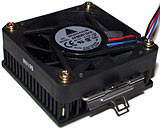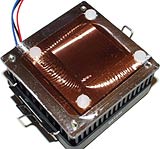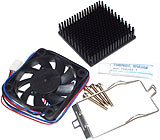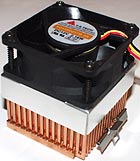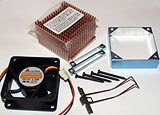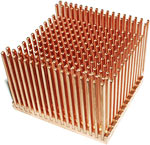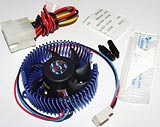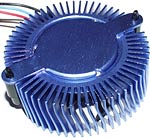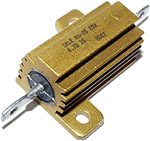
Chip cooler round-up!
Review date: 24 October 2000.Last modified 03-Dec-2011.
Modern PC CPUs are generally rated to operate with a quite wide range of die temperatures - the temperature of the actual processor silicon inside the chip package. Current Socket A AMD Athlons, for instance, are good for a 0 to 90 degree Centigrade temperature range.
If your CPU's core temperature gets higher than its rated range, you'll have a flaky computer. You're not likely to actually damage the CPU - modern small-die processors can occasionally cook themselves, but only if they're run with no CPU cooler at all - but a computer that falls on its face every half-hour may well be damaged in a much more dramatic way by its frustrated user.
For most purposes, low performance "stock" CPU coolers are perfectly adequate. Boxed Intel Socket 370 CPUs come with neat and easy-to-install coolers. But at the moment there might as well be no such thing as a retail-boxed AMD CPU - everybody just buys the same Original Equipment Manufacturer bare chips as are used by system assemblers - so if you buy one of those, you have to buy a cooler with it. And there's no harm in getting a chunkier-than-normal one.
And then, there's overclocking. If you're one of the merry few that run your CPU faster than stock, a good-sized cooler is an essential accoutrement. Modern CPUs actually run cool enough that just scraping the cheapo thermal pad off a stock cooler and replacing it with a smear of heatsink grease is enough to deal with many processors' cooling needs. But when you're really increasing the heat output by goosing the CPU voltage to make it stable at an elevated core speed, another few bucks for a big cooler's a small price to pay for the performance of a processor five times as expensive as the one you bought.
And some people need CPU cooling in odd places - rack-mount computers, and other cramped cases.

Clockwise from bottom left: Thermaltake Blue Orb, Thermaltake Chrome
Orb, Kanie Hedgehog 238M, Just Cooler P-925, Alpha PAL15.
For all of these reasons, after-market coolers may be for you. And since many of them are pleasingly cheap, there's no harm in getting a shiny show-off cooler to go with your new CPU even if you don't intend to run it faster than normal. Particularly in Australia, it never hurts to have a bit more cooling.
I've checked out a couple of low-cost pretty-coolers, a super-slimline unit, a teeny one for things other than CPUs, and a solid copper monster for when too much heatsink is barely enough. On with the show!
Blue is beautiful
Just Cooler is a Taiwanese company that makes a variety of airflow-related computer gadgets, and their P-925 is a good-sized chunk of anodised aluminium, considering that it costs only $AU22 delivered.
The bottom of the P-925 has a factory-applied square of thermal transfer compound (or, to use the technical term, "goop") on it; you just remove the clear plastic guard and squish it down onto your CPU.
Tweakers will want to wipe off the stock compound and replace it with a much thinner smear, but for less demanding applications this is a simple cooler to install, and should get good contact. The clip's a slightly awkward hinged-ratchet type, but holds the cooler properly on Socket 370 and Socket A CPUs - and probably old Socket 7 and Super7 chips (Pentiums, K6s...) as well.
The Just Cooler 0.84 watt low-profile fan's no wind machine, but it's a three-wire unit that reports its speed to the motherboard, and it gets the job done.
As a low cost, nice looking, easy to install cooler for a stock-speed or mildly overclocked CPU, the P-925 should do well. And it ought to fit on practically any motherboard, too; its cantilevered shape means it clears the power smoothing capacitors that closely surround the CPU socket on many boards.
Just Cooler's page for the P-925
Round. Shiny. Cute.
This is the Thermaltake DU0462 "Chrome Orb". It shares the radial-fin design of the other Orbs, which was... borrowed... from the much more expensive Hewlett-Packard TurboCooler, which begat the current Agilent ArctiCooler, which is by all accounts not quite ready for prime time in the retail market yet.
The radial-fin design, whoever makes it, uses a relatively low-power fan and fins arranged for low air resistance but lots of air flow. Even Thermaltake's bargain-basement version of it works as well as a considerably heavier conventional heat sink and fan.
Earlier Orbs had a nifty twist-clamp locking mechanism that worked very well with Socket 370 CPUs, and could kill Socket A ones stone dead in one twist. Thermaltake flailed around a bit trying to come up with a better clip design, and they've settled on the Chrome Orb's stiff springy piece of metal, which isn't the easiest clip in the world to attach, but also isn't going to snap your AMD processor like Pocky.
The Orb sticks out enough around the socket to make it a bit of a tight fit on many motherboards. It only actually fouls the power capacitors on at one board that I know of, the Abit KT7 (reviewed here). A brief assault with a grinder solves that problem.
The base of the Chrome Orb has pre-applied thermal compound with the consistency of chewing gum left on the bedpost for about a week. You peel off the backing plastic before you install the cooler, and you'll need to scrape the cooler clean and put grease on it if you want to remove it and use it again.
At $AU36.30 delivered, this is a mid-priced cooler, but it's still cheap compared with even bargain basement CPUs, and its performance is good. Not as good as its space-age looks might suggest, but good enough for most purposes.
Thermaltake's page for the Chrome Orb
Alpha slims down
Alpha make very well engineered and surprisingly reasonably priced CPU coolers with top-notch performance. But the average Alpha cooler's a big blighter. It, and practically any other CPU cooler, isn't going to be suitable for use in a really cramped case, like one-unit rack-mount computers or other low-profile systems.
Of course, most rack-mount computers don't need a big CPU cooler, because they run weedy CPUs. An old 486 is fine with a plain heat sink (and no fan), as long as the case it's in has good enough air flow.
If you want to build low-profile PCs with modern CPUs, though - and with Celerons and Durons as cheap as they are, it's a very tempting prospect - you'll need a decent cooler that takes up as close to no room as possible.
The PAL15, which is selling for around the $US30 mark, addresses this need. Bottom to top, it's only about 28mm in height, including the heads of the fan mounting screws. It's slightly smaller than one of the 60mm fans that come with other Alphas.
Like the other current PAL series coolers, the PAL15 has a copper heat spreader inlaid into the base of the heat sink. The spreader helps to couple the small contact point of modern processors to the large radiative area of the heat sink.
All current PAL-model Alphas, including the PAL15, have four plastic feet on the bottom of the heat sink to help keep the cooler stable on modern small-die Intel CPUs. The older Plastic Pin Grid Array (PPGA) Celerons have a much larger contact point; old-style coolers used on FC-PGA chips can wobble around and fail to make good contact.
The Alpha baseplate design should work fine with all current Socket 370 and Socket A processors - P-III, Celeron, Duron and Athlon. The AMD CPUs have rubber dots on top to keep coolers stable; the Alpha plastic feet don't interfere with them.
Here's the PAL15, on the left, compared with the special slimline cooler that comes with the PC Chips Book PC I review here. I was never very confident about the capabilities of the little PC Chips cooler; I think the Alpha cooler would fit in its place, and if you're building a high speed Book PC, it'd be a good idea.
The PAL15's fan's very slim indeed, but it moves about the same amount of air as the fatter fan on the Just Cooler P-925. You wouldn't believe that just looking at the manufacturers' specs, though.
Alpha rate their fan, mounted on the heat sink, as being good for 0.37 cubic metres per minute (about 13 cubic feet per minute) of airflow. Just Cooler rate their fan at about 0.5 cubic metres per minute, but that's an unqualified figure, which means it's probably "free-air" - how much air the fan can move when it's just hanging there in space. Put it on the heat sink and your air flow drops.
No Alpha coolers come assembled; you get it as a box of bits. It's easy for anyone with a screwdriver to put the processor together in a couple of minutes, though.
The PAL15 is particularly easy to assemble, because there's no air-guiding shroud over the heat sink. All of the larger Alpha coolers use a shroud to increase their efficiency.
It's easy to install, too, because it uses the same swing-clip attachment gadget as all of the other socket-CPU Alphas.
You get a little tube of heat sink grease with the cooler, and the instruction sheet tells you what to do, in English.
This isn't a cooler for the rabid overclocker. It'd be fine for stock-speed basic computers, but you can get a bigger cooler with the same performance for less. Alpha quote the PAL15's thermal resistance as being up around 0.8 degrees Centigrade per watt, versus less than 0.4 degrees for bigger Alpha socket-CPU coolers.
For a cooler as small as this one, though, the PAL15's a gem.
Buying one
Alpha are in the happy position of being able to sell CPU coolers to distributors faster than they can make them, and so they've discontinued their online shopping service for the time being. This means you've got to buy their coolers from resellers. There's a list of them here.
Rare metal
The Kanie Hedgehog 238M is a CPU cooler for people who reckon that Alphas just aren't extreme enough.
My Hedgehog came from Cool PC here in Australia, who have as I write this sold out of them, but more will presumably be on the way soon. The 238M's $AU79, which is not very much more expensive than a similar-shaped Alpha, especially if you have to buy that Alpha from overseas.
The Hedgehog's basic design is very Alpha-esque - lots of tall pins, shroud, big fan sucking air through the heat sink - but that heat sink's not made of aluminium. It's made of copper.
The aluminium used for almost all PC heat sinks (usually some flavour of 6063 alloy, for the metalworkers out there) is strong, light, not terribly expensive and has good thermal and electrical conductivity.
But aluminium only has about half the thermal conductivity of copper, which is about as good a thermal conductor as silver. Higher thermal conductivity lets heat get from the CPU contact patch to the whole pin surface area more easily; the better your thermal conductivity, the better your heat sink cools the CPU.
So why aren't all heat sinks made of copper? Well, copper's structurally lousy - either very soft, or too brittle to be used for heat sink pins, depending on how it's treated. The Hedgehog's made of soft copper, and comes with a stern warning about not grabbing its heat sink by the pins, lest you bend them.
Copper's also very heavy. Make the exact same heat sink out of copper instead of aluminium and it'll weigh about 3.3 times as much. The Hedgehog 238M weighs a hefty 445 grams all told. That's almost a pound!
The weight of the thing makes it a dodgy proposition if you're installing it on a CPU in a "slotket" adapter card, to let you use Socket 370 processors on older Slot 1 motherboards. That much overhanging weight puts a lot of strain on the CPU mounts, which in many slotkets are pretty slapdash affairs.
Not that many people don't install Gargantuan hunks of metal on their Slot 1 or Slot A CPUs - Alpha's P7125M60 for Slot A Athlons and old-model "SECC" Intel CPUs is an aluminium monster that weighs more than the Hedgehog. But it mounts on a full processor cartridge, not a flimsy slotket.
Like the Alpha coolers, the Hedgehog comes as a kit. And, like the Alpha kits, this one's very easy to put together. It comes with the same sort of clip as the Alphas, too, which makes it simple to install once you've built it.
The Hedgehog comes with a high-output Y.S. Tech fan, which shifts about 50% more air than the Sanyo Denki fans that come with the larger Alphas.
The Hedgehog heat sink comes shrink-wrapped, to keep it shiny and un-corroded. Corrosion on the pins shouldn't make much difference to anything, but a layer of oxide on the bottom of the sink would impede heat transfer.
Pretty, ain't it?
The Hedgehog has a plain flat base plate, with a rebate for the end of the Zero Insertion Force socket that contains the cam-activated CPU locking mechanism. This means I'd be a bit nervous about using a Hedgehog with an FC-PGA CPU, especially if the motherboard was going to end up mounted vertically, rather than horizontally. All of that weight bearing down on one edge of the CPU core could do it a mischief.
Fortunately, there's something you can do about this problem. Shim your CPU. A square of metal just the right size between CPU and cooler, with cutouts for the CPU core and any other top-of-chip components, takes the strain off the core. And Cool PC also sell shims for FC-PGA and Socket A CPUs.
Socket A CPUs are much more fragile than Socket 370 ones. The top of the CPU, on which the cooler sits, has similar physical properties to a little bit of glass. Get your cooler installation wrong, and it's easy to bust off a corner of the top of the CPU.
This seldom actually kills the chip, but it's disturbing, especially if you fail to clean up the fragments properly and grind little bits of glass between the cooler and the CPU on your next mounting attempt.
The four little rubber dots stuck to the top of the Socket A CPU package aim to reduce this problem; they stop you from getting your cooler too far off level. But they're not perfect.
This Japanese-made copper shim aims to solve the problem, by giving the cooler a much larger contact area.
The hole in the middle is for the CPU core; the slots around it are for the little surface mount components on the top of the chip package.
Cool PC sell the shims for $AU29.
They also have simple, Aussie-made shims for Socket 370 CPUs. These only need the one rectangular hole in the middle, and cost a mere $AU5.
The Hedgehog and shims came from Cool PC.
Baby blue
The TGF020 "Blue Orb" is another Thermaltake product, and it's based on the same radial fin design as the bigger Orbs. It's only about 5.5 centimetres in diameter and about two centimetres high, though, and it's meant to be used to cool motherboard northbridge chips (the ones that usually get a little green passive heatsink), graphics card main chips, and so on. It costs 4AUD27.50, delivered.
Putting a better heatsink on a motherboard chip isn't a bad idea if you've got one that runs hot - dual processor boards, in particular, stress the northbridge more than it may like. And, again, overclockers need more cooling - if you're running higher-than-normal Front Side Bus speeds, the northbridge heats up.
Motherboards that use the normal little-green-heat-sink on their northbridge chip hold them on with a couple of simple spring-loaded split-pins, which are quite easy to remove and replace with a pair of pliers. It's not a bad idea to pop the stock heat sink off and add a dab of thermal grease under it, even if you're not going to do anything else; most of the green-sinks are put on "dry" and so achieve very little.
Many video cards also have a couple of cooler mounting holes on either side of their main chip, even if they don't actually use them for anything, and just have a cooler stuck on with thermal cement or, more commonly, thin high-conductivity double sided tape.
It's seldom very difficult to remove even bonded-on coolers; a flat-blade screwdriver to lever it off, and a piece of cardboard to protect the board from damage, usually does it.
The Blue Orb gives you a couple of mounting choices. The best method is using the supplied pair of spring-pins.
The holes in the Blue Orb base for the spring-pins are about 55 millimetres apart, which comes fairly close to matching the hole spacing on various motherboards and video cards. There's enough wiggle in the pins that you can tilt them in or out to match slightly different hole spacing.
There's a little plastic pack of thermal grease in the Blue Orb package, too, for people that use the pin mounting.
If the pins don't match the thing you're putting the Blue Orb on - its holes aren't spaced appropriately, or it has no holes at all - there's a square of double-sided thermal tape included, too.
Thermal tape's touchy stuff - for decent conductivity, it needs to be very thin indeed, which makes it easily damaged - but a decent-sized square of it like this isn't too hard to deal with. Of course, if you want to re-use the Blue Orb, you'll need more tape.
The Blue Orb has a three-wire speed reporting fan, but it also comes with a four pin Molex plug passthrough power adapter, which lets you use it in systems without a spare three pin header. Using the adapter means you can't monitor the fan speed, but it makes the cooler useable in anything with a standard PC power supply.
Joe Average doesn't need the Blue Orb. But if you've got a basic-model video card that comes with just a passive heat sink and no fan, a Blue Orb may let you crank its speed up considerably further than you could with the stock hardware. And it should do a better job of keeping motherboard chips cool than the usual solution to the problem - just sticking a dinky fan on top of the plain green heat sink.
Plus, of course, it looks cool.
Thermaltake's page for the Blue Orb
Further reading
In case you are seized by a perverse and terrible desire to know more about the electrifying field of processor cooling, check out my piece on how to install coolers properly, here. For light relief, the article on CPU water cooling here may amuse you. And don't forget my piece on how to fit a Big Serious Fan to your PC case, which is here.
Buy CPU coolers!
Readers from Australia or New Zealand can purchase all kinds of CPU
coolers from
Aus PC Market.
Click
here!
(if you're NOT from Australia or New Zealand,
Aus PC Market won't deliver to you. If you're in the USA, try a price search
at
DealTime!)
